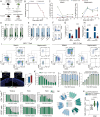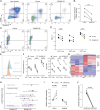Distinct Immune Homeostasis Remodeling Patterns after HLA-Matched and Haploidentical Transplantation
- PMID: 39225336
- PMCID: PMC11497014
- DOI: 10.1002/advs.202400544
Distinct Immune Homeostasis Remodeling Patterns after HLA-Matched and Haploidentical Transplantation
Abstract
Allogeneic hematopoietic stem cell transplantation (allo-HSCT) is a widely used treatment for a variety of hematopoietic disorders, and also provides a valuable platform for investigating the development of donor-derived immune cells in recipients post-HSCT. The immune system remodels from the donor to the recipient during allo-HSCT. However, little is known about the cell profile alterations as donor homeostasis rebalances to recipient homeostasis following HSCT. Here, multi-omics technology is applied at both the single cell and bulk sample levels, as well as spectrum flow cytometry and fluorescent transgenic mouse models, to dissect the dynamics of the rebalanced homeostatic immune system in recipients after allo-HSCT. The data reveal that all immune subpopulations observed in donors are successfully restored in recipients, though with varying levels of abundance. The remodeling of immune homeostasis exhibits different patterns in HLA-matched and haploidentical HSCT, highlighting distinct biases in T cell reconstitution from the central and peripheral pathways. Furthermore, ZNF683 is critical for maintaining the persistence and quiescence of CD8 T-cell in haploidentical HSCT. The research can serve as a foundation for developing novel strategies to induce immune tolerance.
Keywords: ZNF683; allogeneic hematopoietic stem cell transplantation; immune homeostasis; immune reconstitution; immune tolerance.
© 2024 The Author(s). Advanced Science published by Wiley‐VCH GmbH.
Conflict of interest statement
The authors declare no conflict of interest.
Figures







References
-
- Kanakry C. G., Fuchs E. J., Luznik L., Nat. Rev. Clin. Oncol. 2016, 13, 132. - PubMed
MeSH terms
Substances
Grants and funding
LinkOut - more resources
Full Text Sources
Research Materials
